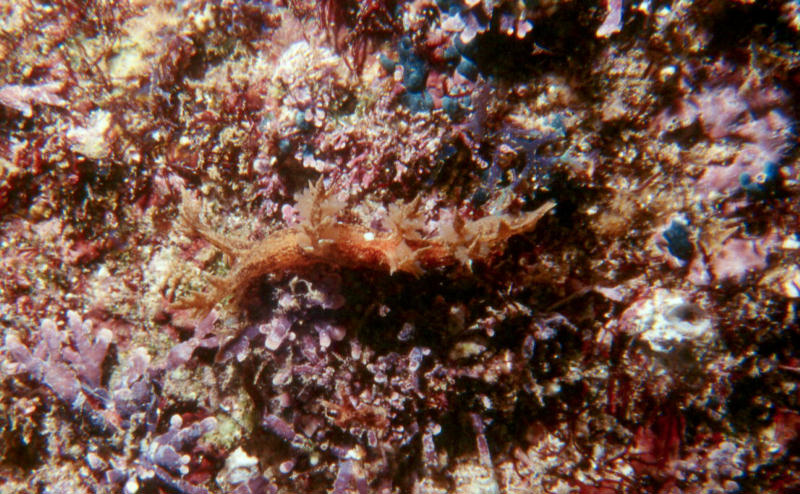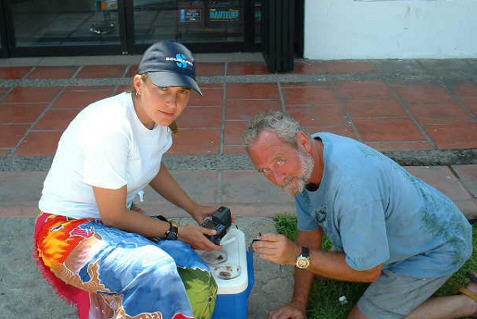 |
Bornella sarape
Photo courtesy of Dr. Hans Bertsch
Bornella sarape Bertsch, 1980
To our knowledge, this species has not been collected since it was named. Hans originally named Bornella sarape based on holotype specimens he and several others had collected from the type locality of Bahía Carisalito, 4 km north of Las Cruces (east of La Paz), Baja California Sur (24E 13' N; 110E 05' W). Several years later, Gary MacDonald and James Lance collected two specimens intertidally at Sayulita, Nayarit, Mexico.
The 42 mm long living specimen we illustrate here was collected by Ali on 2 June 2002 at Los Arcos, Bahía de Banderas, Jalisco, Mexico. They represent the first record of this species in the state of Jalisco, and, as mentioned, the first sighting of this species in more than 25 years!
As can be seen by the photos, it is an extremely cryptic species , which most likely helps account for the rarity of its being found by researchers. The following description is taken from Hans' original paper.
"...This species has a thin, laterally compressed body. It is yellow-brown, covered with irregular black markings. Dorsal processes and rhinophore sheaths have the same coloration. The mouth opening is surrounded laterally with oral lobes, each consisting of 2 rows of papilae, 4 smaller papillae at the base of 6 larger ones.
A dorsal ridge extends lengthwise down the animal's body. The ridge begins as two separate ridges coming from the rhinophoral sheaths, fusing medially, and then terminating. The whitish-colored dorsal anal opening is immediately anterior to the second pair of dorsal processes, and opens just to the right of the dorsal ridge. This was not illustrated in the original description , but is clearly visible in the accompanying photographs.
Each rhinophore is nestled in a large, flattened rhinophoral sheath. The sheath branches distally (at one-half to two-thirds its length) into a round portion enclosing the rhinophore stalk, and a flat, palmate-shaped flap.
There are 3 to 4 pairs of branching dorsal processes. Gills are positioned at the junction of the main stalk and the branchings. The gills are uni- or bi-pinnate, and are a translucent whitish color; they are not prominent, but can be seen fairly easily with a dissecting microscope.
The radula consists of a series of rows, each with a prominent median tooth flanked by smooth, claw-shaped laterals. The central tooth has a large, chevron-shaped cusp with a depression behind it into which the convex undersurface of the adjacent tooth fits. The sides of the cusp are grooved, resulting in a series of small basal denticles. The jaw has the rounded shape characteristic of most dendronotids..."
Bornella sarape swims by lateral bending of its body, with all its appendages waving and flapping through the water.
Hans chose the specific name sarape in reference to the brightly-colored traditional Mexican blanket that is worn around the shoulders.
Hans Bertsch and Alicia Hermosillo
Alicia Hermosillo and Hans Bertsch

|
Alicia is a Ph.D. candidate at the Universidad de Guadalajara, working on the ecology and taxonomy of opisthobranchs in Bahía de Banderas. Hans recently visited her, and was called "Buzo Clásico" (Classic Diver) because of his worn out and ancient equipment. This photograph shows Ali using her high-tech digital camera to photograph specimens collected. It was taken in front of the Buceo Vallartech dive shop (owned and operated by Roberto Chavez Arce), in Puerto Vallarta.
Hans can be contacted at hansmarvida@cox.net
Alicia can be contacted at gueri25@hotmail.com |
